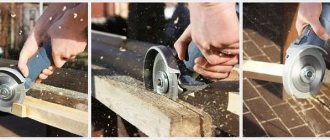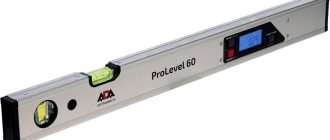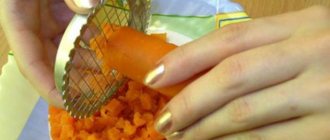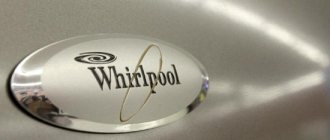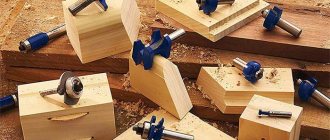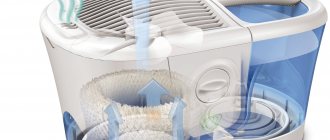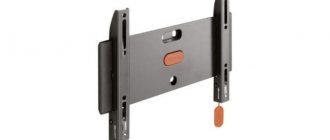There is a jigsaw not only in every workshop, but also, perhaps, in every home. This tool has gained such popularity due to its versatility and compactness. With its help, you can cut various sheet materials: wood of any species (from the softest to very hard); sheet metal; plastic; glass and ceramics, etc.
To work with a particular material, you need to choose the right saw blade (more often called simply a “file”), since the quality, cutting speed and overall ability to work depend on it. This will be discussed in this article.
Each saw has its own unique parameters, the combination of which determines the material that can be cut with it, as well as other cutting characteristics: the quality and speed of the saw. In addition, each file has design features that allow it to be used with one or another jigsaw. A separate article is devoted to jigsaws, but choosing the “right” file will be discussed in this article.
Why is it important to choose the right saw blades?
Only with the right choice of working attachments can you achieve high efficiency, productivity and quality of work performed. A jigsaw is a multifunctional cutting tool that is designed for sawing sheet materials - wood, metal, ceramics, plastic and more. To work with these materials, appropriate blades are installed in the jigsaw clamp.
The blade is a consumable material, but the process itself and the final result of the tool depend on the correct choice of the jigsaw file. To increase productivity and quality of work, you should select the appropriate jigsaw files for each type of material. The number of saw blades produced today is quite large, and therefore many questions often arise about which blades are the best and what to buy. This material will help you figure this out.
How to choose the best and most reliable jigsaw blades?
A review of popular brand models allows you to find the best option for your wallet and the amount of work to be done.
Simple recommendations and convenient markings will help you make the right choice. Retail stores and many specialized online construction sites will help you decide where to buy cutting consumables. Study reviews from real customers, compare products by price and order jigsaw accessories online from the online store.
Very often, abandoning cheap counterfeit products in favor of branded products pays off. Additional costs when purchasing consumables will be paid off by the high quality of the cut, the absence of additional processing, the speed of the process and the absence of injuries during the work.
By what parameters are canvases classified?
A jigsaw blade is like a drill bit. When choosing, you need to take into account a number of main criteria. These criteria depend on the classification of electric saw blades. jigsaws. The classification is as follows:
- Shank type
- Material from which the nozzle is made
- Tooth shape
- Length
- Nozzle width
- Tooth pitch
- File thickness
Jigsaw blades differ in all these parameters. It’s clear what a jigsaw blade is for a power tool, and how they differ from a manual jigsaw. We will look at all types of files according to their classification in more detail below.
Types of blade shanks for jigsaws
Initially, we will pay attention to the design of the shanks on the blades. If you use one tool, then you probably don’t know that the saw holder devices are different. This depends on the tool manufacturer. According to the design of the shanks, the nozzles come in the following shapes:
- The T-shape design is the most common design option and was developed by Bosch. This type of shank is present not only on the tools of this company, but also on most other brands of jigsaws
- The U-type is a rare shank type in Europe as it is an American invention. Suitable for older models of tools from brands such as Black&Decker, Skil, Ryobi and others. To do this, the jigsaw must have a saw holder with a screw and collet clamp
- With two holes - this type of shank is extremely rare today. Such blades were used on the very first Makita brand tools
- Double T-shaped or with two stops - such files are also extremely rare today. They were developed by Bosch and are a double T-shape. However, they did not gain popularity due to the complexity of the saw holder design, so today they are found as a rarity
- L-shaped is another type of fastening that is used on Peugeot jigsaws
Today, only the first two types of shanks are found on jigsaw files. To find out what kind of blade you need for a tool, you should look at the instructions or technical description on the Internet for the corresponding brand and model of the tool. You can also clarify the type of holder by disassembling it. If your instrument has a rare saw blade design for which it is impossible to find blades, then this can be corrected by replacing the rod. The video material describes what types of saw blade shanks there are and how they differ.
This is interesting!
To avoid questions about how to insert a file into a jigsaw, it is recommended to choose modern tools with T-shaped saw holder designs. After all, shops and markets are overflowing with canvases with this type of shank design.
How to properly insert a file into a jigsaw
In modern models of jigsaws, fastening of files is carried out in three ways: block, screw, quick-clamping. The first two species belong to the castle group.
Hex key mount
Shoe mount
This is a common blade clamping mechanism. Its device includes a block and two screws that tighten it to the movable rod. One of the main advantages of this method is its versatility. The mounting screws have a decent tightening reserve. This makes it possible to use different types of shanks.
The mechanism also has a drawback: during installation of the blade, the blade often warps, which complicates the work and provokes breakage of the tool.
The process of replacing a file in a block mount:
- loosen the screws one by one using a hexagon (do not unscrew completely);
- remove the old canvas;
- install a new cutting element (teeth forward);
- tighten the bolts evenly.
The fasteners are tightened smoothly with a half turn. It is important to control the position of the canvas. It should be at an angle of 90° to the base of the power tool. After tightening, you can start working.
Screw fastening
This type of fastener is positioned as a more convenient and durable clamp than a block clamp. It allows you to use elements with different shanks when working with the tool. The device includes one screw, which is located on the side of the jigsaw. Replacing the blade is quick and easy. It is fixed quite evenly, but the installation angle should still be checked.
The process of replacing the canvas:
- loosen the fixing screw;
- remove the old file;
- a new blade is inserted into an empty groove, the evenness of its location is assessed;
- slowly tighten the screw.
Do not tighten the lock too much. Otherwise, the cutting element will vibrate strongly during operation.
Quick release with side lever
Quick release with front lever
Radial clamp
Quick release mount
This is the most convenient type of fixation. You can replace the working element without tools. It will only take a few seconds. The method also has disadvantages. One of them is the ability to use only files with a certain type of shank with such a mechanism. The reliability of fixation does not inspire confidence, especially in budget models. A guide to well-known brands of jigsaws will help you make the right choice.
There are three types of quick-release fasteners. They are determined by the location of the lever: lateral, frontal, radical.
The installation process is extremely simple:
- bend the movable lever;
- holding it with your finger, install the file into the groove;
- After immersing the tail part, release the lever and slightly bring the sawing element into the groove.
A click indicates that the jigsaw is ready for use.
What does the color of the shank mean on canvases?
When purchasing, you can see that the tail parts (and sometimes the entire canvas) are painted in different colors. If you're wondering what this means, then it's time to find out the answer to this question. The colors of jigsaw shanks and files are as follows:
- Gray ones are the most popular. They are used for wood processing
- Blue - used for working with metal materials
- White - less common, and means the ability to process metal and woodworking materials
- Red - used for cutting plastic
- Black - designed for sawing all other materials such as ceramics, marble, granite
Knowing the color, you definitely won’t go wrong in choosing equipment for the appropriate work.
What materials are jigsaw blades made from?
What the nozzle is made of is another important indicator that affects the efficiency of work, service life, as well as the possibility of using saws for certain jobs. Depending on what materials the nozzle is intended for sawing, manufacturers make them from the following steel alloys.
- For sawing metal. Metal blades for jigsaws are made from special high-speed steel HSS. The teeth on such blades are small, and their size depends on the degree of hardness. The harder the metal used to make the nozzle, the smaller the teeth. Also, saw blades for cutting metal are made using two types of alloys: HSS (high speed steel) and HCS (high carbon steel). Such blades are also called bimetallic or Bi-Metal, and they are intended for figured sawing of sheet materials made of steel and wood
- For sawing wood materials. Initially, the jigsaw was intended specifically for woodworking. Moreover, it was used for cutting sheet wood materials, but soon the functionality of the tool began to expand, and today it can be used to cut not only wood, but also metal and ceramics. For the manufacture of blades for cutting wood materials, steels containing chromium and vanadium, as well as with a high carbon composition, are used. Chrome vanadium blades are designated CV (chrom vanadium), and are suitable for working with fiberboard, chipboard, MDF, plywood and other similar materials. If it is necessary to cut wood or plastic, then nozzles with the designation HCS are selected, which means high-alloy carbon steel. Saw files for woodworking are characterized by large tooth sizes and their spacing. For cutting chipboard, fiberboard and plastic, it is better to choose bits with fine teeth up to 3 mm and a small setting
- For laminate. These are special blades that differ from those used for sawing wood. Their main difference is that, in addition to small teeth, they have reverse links. These reverse links prevent the formation of chips on the front side, which is important when processing decorative materials. Laminate sheets are made using two types of steel, whereby the nozzles are called bimetallic and are designated BIM (bi-metal)
- For ceramic tiles - attachments for sawing high-strength materials such as ceramic tiles, foam blocks, marble, etc. are made from tungsten carbide alloy. In addition to the use of a special high-strength composition, such nozzles have a distinctive design from all others. If the blade is made of tungsten carbide alloy, then the marking contains the designation HIM or HM (hard material). The hardness of the material reaches 79 HRC. If a file has the designation DIA, this means that it is made using diamond coating. Diamond blades are expensive and are intended for cutting ceramic tiles and granite
- For cardboard, this is a special type of cutting element for jigsaws, which has a sharpened edge of a wave-like design. Such files are used to cut foam, rubber, cardboard and other types of soft materials. The file does not have sharp teeth, but instead there are wavy, sharpened tubercles. This design ensures that the material does not crumble and does not tear. As a result, the cut is smooth and neat. Jigsaws with cardboard files are also used to cut carpets
These are the main types of blades for jigsaws, which are designed to work with specific materials. However, there are also universal attachments. A distinctive feature of such blades is that they have large teeth on one side and small ones on the other. As practice shows, it makes no sense to buy such attachments, since their main advantage is that you do not need to use more than two consumables when processing dissimilar materials.
Classification of files for electric jigsaws
Delicate cut . If you need to cut plywood, plexiglass, plastic, laminate, fiberboard and chipboard sheets accurately and evenly, we recommend choosing products with fine teeth. They make a smooth cut without chipping. The best option would be saw blades for the Ermak T101V electric jigsaw. The main condition for quality work is that the thickness of the workpiece should not be more than 7.5 cm.
Quick cut . If you need to quickly cut an old window frame and a perfect cut is not important, we recommend buying Ermak electric jigsaw files with large teeth. The more massive the teeth, the faster the work is done. It is important to remember that the cut will be rough and unsmooth. Choose from the T-144D saw blade for softwood up to 5cm thick and the T-244D saw blade for easy use on 10cm thick wood.
Figure sawing . If you need to cut a circle in a tree, your choice is Ermak -119VO. Thin blades are designed for figure cutting. With their help, it is easy to cut out ovals, diamonds and circles in plywood and chipboard sheets. Thanks to the fine teeth, a smooth and even cut is obtained.
IMPORTANT. For cross cuts, choose straight teeth; for cutting along the grain, use slanted teeth.
Sawing metal . For cutting metal up to 3 mm thick, use the T-118A Ermak, designed for non-ferrous metals and steel. The key difference is the very fine teeth. This model is often used for cutting plastic.
To work with very thin metal sheets up to 1.5 mm thick, buy T-118G files.
Sawing plastic . If you need to cut a plastic pipe or trim a window sill, use models with large teeth designed for wood or metal. You can also use a fine-tooth model, but you will have to work very carefully and slowly so that the sawdust does not soften. Plexiglass and thin plastic are perfectly cut with wood saws with small teeth.
What blades come in tooth shapes?
The shape of the teeth plays a significant role when working with different materials. It is imperative to take into account the design of the teeth, otherwise in the process of processing certain materials you may encounter a decrease in productivity, and sometimes the operator may even find that the jigsaw begins to cut crookedly. We will consider further what types of teeth are found on jigsaw blades:
- Set milling teeth - the teeth have bends in different directions, which is achieved by 1.5 mm by setting them depending on the thickness of the blade. Routing plays an important role, as it eliminates the occurrence of strong heat and effectively removes sawdust from the cutting line. Files with this tooth shape are designed for processing hard wood, and are also used for sawing plastic and non-ferrous metals
- Wave-shaped milling - the setting is presented in a group deviation of the teeth to the left and right. Each subsequent tooth has a distinctive amount of inclination, due to which a wave-like structure is formed. These types of files have found their application for clean cutting of plastic materials, as well as non-ferrous metals
- The polished shape of the teeth is also called conical. This type of teeth is popular when it is necessary to obtain a clean cut on workpieces. They are used for wood, plastic and other polymers. They have one drawback - they heat up quickly, so they cannot be used for a long time
- Sanded set links - they are used to quickly cut fiberboard, chipboard and plywood. In this case, the cut turns out to be sloppy, which leads to the need for additional processing with files.
Different manufacturers strive to improve their attachments, so it is possible that other variants of cutting edge shapes are also available on sale.
What it is?
A jigsaw file is a blade equipped with teeth of one type or another, fixed at one end to the movable rod of the tool. Since all materials have their own properties and characteristics, a large number of varieties are produced. They are designed to solve various problems, cutting certain materials. As a rule, craftsmen purchase sets of several types of cutting tools.
Selection criteria may be:
- The most popular and common types of cutting.
- Purpose for a particular material.
- Creation of a universal set that allows you to perform most types of processing.
Separate, specialized samples are also available for sale. They are purchased to perform specific work according to previously known parameters of the material and cutting conditions. The choice of file type is determined by the user’s level of training, experience and knowledge. In order to avoid mistakes and choose the best option, you should study the features and characteristics of the cutting tool.
What does the width of the jigsaw blade affect and what are they?
You may not have noticed that the canvases differ in width. This parameter also plays an important role, and not only the service life of the jigsaw attachment depends on it, but also the ability to make straight and figured cuts.
A wide blade is more stable, but it cannot be used to make a shaped cut. Another thing is thin files, which not only cut neatly, but also allow you to easily negotiate turns, making shaped cuts.
The width of the canvas is available from 5 to 45 mm. When purchasing you need to remember the following:
- If you plan to make a straight cut, then choose a wide file
- For a shaped cut you need to take thin files
Manufacturers indicate on the packaging of a set of blades not only the width of the files, but also the type of cut for which they are intended - straight, rectilinear, figured.
Marking of Metabo files
Metabo also marks its files with a digital code. The code looks like this: 23651, 23640, etc.
Metabo's digital code is not as informative as DeWalt's and Makita's. Moreover, on the packaging they do not provide compliance with Bosch codes. So you need to open the Metabo website and look at the characteristics of the file by number. And on the website, for most of its files, Metabo indicates compliance in Bosch encoding. Metabo website.
Since Metabo files are made in Switzerland, as well as for Bosch, it is likely that these are mostly copies of Bosch files.
The thickness of the blades affects the deflection of the nozzle
Another factor that influences the quality of the cut is the thickness of the saw attachment. They come in two types - thick and thin. Each type has its own advantages and disadvantages, as well as a corresponding purpose.
- Thin blades provide an even and accurate cut, but during the sawing process they vibrate strongly, which depends on the hardness of the material being processed. In addition, their advantage is the low load on the tool, and the disadvantage is that they cannot be used for corner cuts.
- Thick files provide an even perpendicular cut and can be used for angular cutting of materials. Their disadvantage is that due to their size they increase the load on the engine and gearbox of the tool, so they cannot be used on low-power jigsaws
Even thick attachments are not suitable for the quick-clamping mechanism of the saw holder, so it is necessary to choose medium and small blades in thickness.
Sizes of produced files
- Length. This saw blade parameter varies in the range from 40 to 250 mm. A longer saw can be used to cut thicker workpieces. Moreover, the depth of the cut made depends on the properties of the tool itself on which the nozzle is installed. To work with thin materials, it is better to choose shorter files; they will not deform the workpiece and will make a more accurate cut.
- Width. The choice of product for this parameter depends on the work to be done. Wide bits are good for making straight cuts. For curved cuts, it is better to choose a narrower blade. It will be easier to promote him through the material.
- Thickness. The value of this indicator affects the quality of the work performed. A thin saw blade deviates more during operation, and the cut is not very even. However, you need to know that very thick attachments can only be installed on quick-release jigsaws.
What kind of canvases come in length?
It is important to take into account one more parameter - the length of the canvas. Four indicators are used to indicate lengths:
- With number 1 to 75 mm
- With number 2 from 75 to 90 mm and belong to the medium category
- With number 3 from 90 to 150 mm - long
- With number 4 over 150 mm - the longest, which are designed to work with powerful jigsaws
The longer the blade, the thicker the sheet material can be cut with a jigsaw. The choice of blade length should be based on the calculation that the nozzle should be 2 times longer than the thickness of the workpiece being cut. Keep in mind that the large length of the equipment contributes to severe overload of the motor and gearbox of the power tool, so the jigsaw must have sufficient power to be able to use it with saws of 90 mm or more.
Markings on jigsaw blades - what does it mean?
There are no difficulties in choosing blades, since the nozzles are marked accordingly. From this marking you can find out all the detailed information about the cutting element. Let’s find out in detail what the marking of jigsaw blades means, how it is read, and what it is responsible for. Below is an example of jigsaw blade markings, which we will use as a guide when reading the designations.
Also presented above are additional options for shank types that are not found at all today. This is the US-shank and F-shape type standard on Fein models. The marking is indicated on the tail section and is a set of letters and numbers. Let’s look at what the letters and numbers on saw blades markings mean below.
- The first letter is indicated, which indicates the type of shank. As already mentioned, the design of the shanks is different, and the corresponding letter indicates the following types: T - T-shaped design, U - y-shaped, M - suitable for outdated models of Makita brand jigsaws, F - Fein standard
- The next designation in the marking is the length of the blade. The corresponding first number indicates a certain length range. If the number is 1, then this is the shortest file up to 75 mm, and 2 means the blade has an average length ranging from 75 to 90 mm. The number 3 means a length from 90 to 150 mm, and 4 means a blade length of more than 150 mm. After the first digit, additional digital designations (two digits) are written indicating the size of the teeth
- The third, or rather fifth, letter in the marking is. These are four types of letters A, B, C and D, which characterize the size of the teeth from fine to coarse
- After the digital designation, the marking ends with a letter. This letter indicates the accessory of the nozzle. Each letter has a corresponding purpose: F - equipment is made using two alloys, P - blades are thick and are designed for precise cutting, R - the tooth on the blade has a reverse design, X - universal, O - the blade has a narrow back shape
The type of steel from which the blade is made is also indicated on the shank. This has already been mentioned above. There are also English names on the canvases, indicating the type of materials for which it is intended. These designations and their interpretation are as follows:
- Wood - intended for working with soft wood and other similar materials
- Hardwood - used for sawing solid wood materials and PVC
- Inox - a specialized attachment for cutting stainless steel sheets
- Metal - for working with metal workpieces
- Alu - for aluminum
- Acrylic - for polycarbonate
- Laminate - for laminate
- Soft material - for soft materials such as carpet, rubber, foam, polystyrene
This is interesting!
If the blade contains inscriptions such as THICK (thick) and THIN (thin), then this is additional information that indicates the possibility of using the attachment for sawing thick or thin material.
The presence of other designations in English will not be difficult to translate using translators, which will give a clear picture of what specific purposes the nozzle is intended for.
All types of files for woodworking with a jigsaw description and purpose
Let's look at all types of saw blades for wood processing. Each type has a corresponding purpose, which must be taken into account when processing the corresponding types of materials.
How to distinguish a quality canvas from a fake
Jigsaw attachments are produced by various manufacturers: Bosch, Kraftool, Makita, Metabo, Praktika and many others. The price of nozzles from different manufacturers varies accordingly. Craftsmen who deal with jigsaw work every day know not only how to choose and what types of blades there are, but they also know how to distinguish original attachments from fakes.
If you think that the easiest way to avoid falling for a fake is to buy expensive and branded consumables, then you are wrong. Modern unscrupulous manufacturers produce pretty good fakes, which are quite difficult to distinguish from the original, but quite possible if you know some of the features.
- The original nozzle has clear and even edges, unlike fakes. Counterfeits have slightly rounded corners, which indicates that consumables are made from stamped steel
- The presence of signs of corrosion indicates poor quality of the nozzle.
- Fuzzy inscriptions that are distorted and easily erased also indicate that the attachment is a fake
High-quality and original products are sold in special packaging. Usually the set includes five blades, but medium and long blades are sold individually. Please also keep in mind that buying a cheap fake will not only lead to a negative result, but will also cause injury to the operator.
